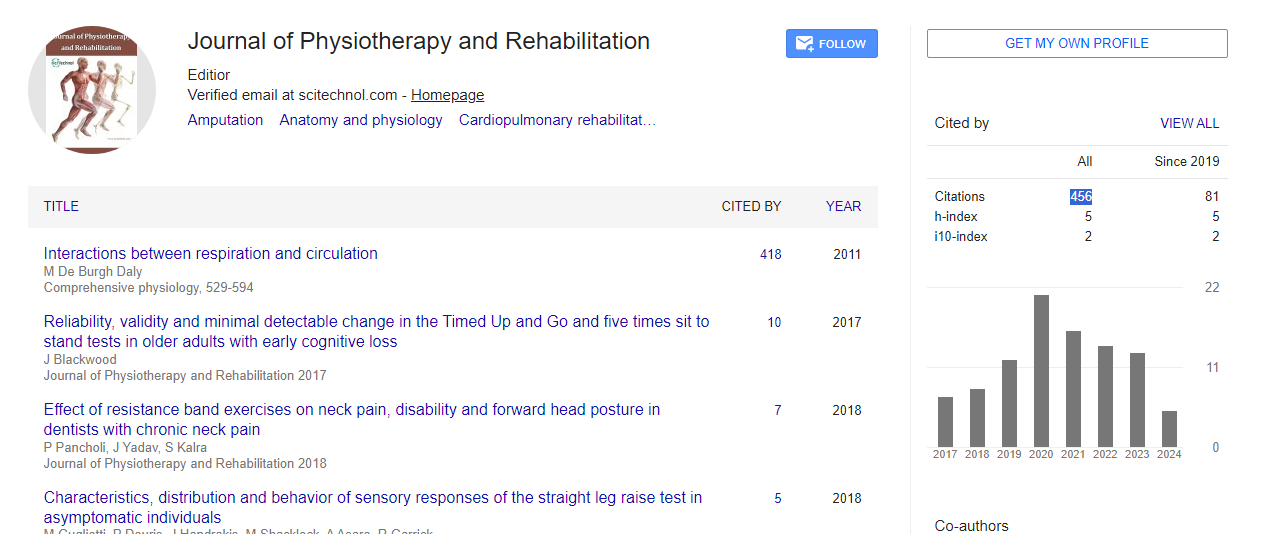Editorial, J Physiother Rehabil Vol: 5 Issue: 12
Principal Causes of Death and Disability in Older
Rohina Joshi*
Department of Medicine, University of New South Wales, Sydney, NSW, Australia
*Corresponding author: Rohina Joshi, Department of Medicine, University of New South Wales, Sydney, NSW, Australia, E-mail: Rohina_Joshi@yahoo.com
Received date: 01 December, 2021; Accepted date: 16 December, 2021; Published date: 23 December, 2021
Citation: Joshi R (2021) Principal Causes of Death and Disability in Older. J Physiother Rehabi 5:12.
Abstract
Adolescents (10–19 years old) comprise a fifth of the Indian population (253.2 million), yet there is very little published information about the burden of disease and injury for this age group. This paper aims to provide a contemporary picture of the leading causes of death and disability for Indian adolescent girls and boys for 2013, and changes in deaths and disability between 1990 and 2013. Data from the Global Burden of Disease (GBD) study for India, for the years 1990 and 2013, were accessed. Data were categorized into two age groups: 10 to 14 years (younger adolescents) and 15 to 19 years (older adolescents) and analysed separately for girls and boys.
Keywords: Death, Disability in Older, Adolescents
Editorial Note
Adolescents (10–19 years old) comprise a fifth of the Indian population (253.2 million), yet there is very little published information about the burden of disease and injury for this age group. This paper aims to provide a contemporary picture of the leading causes of death and disability for Indian adolescent girls and boys for 2013, and changes in deaths and disability between 1990 and 2013. Data from the Global Burden of Disease (GBD) study for India, for the years 1990 and 2013, were accessed. Data were categorized into two age groups: 10 to 14 years (younger adolescents) and 15 to 19 years (older adolescents) and analysed separately for girls and boys.
Adolescents The study shows that for both younger and older adolescent boys and for older adolescent girls, non-communicable diseases (NCDs) and injuries are responsible for a greater number of deaths and disability-adjusted life-years (DALYs) than communicable diseases. Communicable diseases are still important causes of death and disability for young adolescents. Among older adolescents there is an increasing burden of death and disability due to self-harm, road traffic injuries, fire- and heat-related injuries and mental disorders such as depressive disorders.
Although strategies to reduce the burden of communicable diseases among adolescents must continue to be an important focus, innovative, evidence-based strategies aimed at reducing the growing burden of NCDs and injuries must be elevated as a priority. Adolescents (10–19 years old) comprise a fifth of the Indian population (253.2 million), yet there is little information about their burden of disease. Adolescence, perceived as a healthy age, has largely been neglected by the global health community when compared with younger children. Adolescents undergo rapid developments in this period of life which have major health consequences over the lifetime: health- and behaviour-related conditions that originate in adolescence have an impact on adult health with important socioeconomic consequences. For instance, tobacco use, consumption of unhealthy diets and harmful use of alcohol are initiated in adolescence and may lead to the premature onset of several non-communicable diseases (NCDs) such as heart disease and chronic lung disease. In the Indian context, as NCDs and injuries form the major burden of disease and disability, it is important to understand the disease burden in adolescents. This paper aims to provide a comprehensive and contemporary picture of the causes of death and disability for younger and older adolescents in India, focusing particularly on the levels and changes with respect to the burden of NCDs and injuries. An ethics committee approval was not required for this paper as it involved secondary analysis of publicly available data. This study, based on GBD data, provides a comprehensive description of the burden of death and disability and the transition over two decades, disaggregated by age and sex, for Indian adolescents. This paper shows that for adolescent boys and for older adolescent girls, NCDs and injuries are now responsible for a greater number of deaths and DALYs than CDs. Whereas CDs are important causes of death and disability, particularly for young adolescents, the current burden of death and disability from injuries and especially self-harm is concerning
 Spanish
Spanish  Chinese
Chinese  Russian
Russian  German
German  French
French  Japanese
Japanese  Portuguese
Portuguese  Hindi
Hindi 